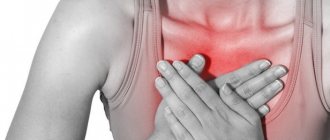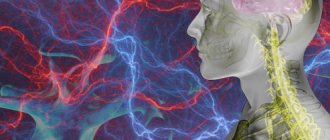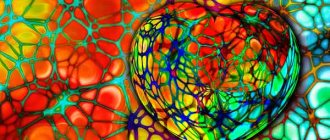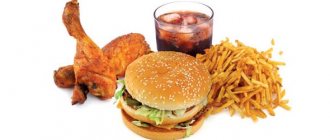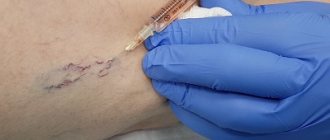- Thoracic osteochondrosis.
Wear and premature aging of intervertebral discs. - Disc protrusion in the thoracic region.
A crack in the annulus fibrosus of the intervertebral disc into which the nucleus is displaced. Because of this, the disc protrudes into the spinal canal. - Hernia in the thoracic region.
Damage to the intervertebral disc with the nucleus extending beyond the spine. - Kyphosis.
Curvature of the thoracic region backwards, away from the chest. - Scoliosis.
Curvature of the thoracic region to the right or left. - Kyphoscoliosis.
Combination of kyphosis and scoliosis: curvature of the thoracic spine in all directions. - Spondyloarthrosis.
Inflammation and atrophy of intervertebral joints. - Radiculitis.
Inflammation of the spinal nerve roots. - Myositis.
Muscle inflammation.
A separate group of diseases of the musculoskeletal system, such as arthritis, should be highlighted. Arthritis of the shoulder joint causes pain in the chest, shoulder blades, neck, and causes numbness in the fingers.
Knees hurt after running
The study of knee joints was the primary task of scientists involved in the study of cyclic sports. Therefore, the causes of knee pain have long been studied and classified.
The main causes of pain in the knee joint:
- Damage to the round cartilage, which in medicine is called the meniscus. Performing sudden movements during training activities can cause the ligaments that attach the cartilage to other cartilage to break. The result is pain, which can intensify after physical activity.
- Ligament damage that occurs due to high stress on the knees. Common in jumping sports where the impact force on the knees is highest. However, injury can also occur as a result of running activities.
- The patella (kneecap) can become unstable when the ligaments are damaged. As a result, the patella may pop out. However, pain can occur without the kneecap popping out.
- Problems with blood circulation in the knees can also cause pain after running. Such pain goes away after some time after exercise, but systematically occurs as a result of physical activity.
- Pathological diseases: arthritis, arthrosis, chondromatosis.
The appearance of painful sensations can occur not only due to pathologies, but also due to improper running with impaired movement technique. For example, poor foot placement not only causes ankle injuries, but can also cause knee damage from impact impacts while running.
You can mitigate the consequences of jogging by mastering the technical elements of running and using special shoes, which have different soles depending on the surface. Regular jogging in sneakers is highly not recommended, especially since there are sneakers that are good at absorbing impacts to the joints.
If knee pain regularly appears after running, you should consult a doctor, since the likelihood of pathologies is extremely high. In this case, the pain will not go away on its own, and random selection of ointments will only mask the problem and will not stop its development.
Heart pain includes:
- Pain due to coronary heart disease (angina)
. The cause of these pains is oxygen “starvation” of the heart cells when the load on it increases. The lack of oxygen supply is caused by a narrowing of the vessels supplying the heart due to the deposition of fat-like accumulations (atherosclerotic plaques) on their walls, as a result of which they lose the ability to expand and provide blood flow adequate to the needs of the heart. Such pain, as a rule, occurs during physical exertion or psycho-emotional stress, has a pressing or squeezing nature, is often localized behind the sternum, less often in the left half of the chest, is relieved (stopped) by taking nitro drugs or when the load is stopped, and is short-term in nature (several minutes) . - Pain during myocardial infarction.
Their character is similar to the pain of angina pectoris, but they are usually longer lasting, may be accompanied by shortness of breath, cold sweat, and are not relieved by taking nitroglycerin. The cause of such pain is a blockage of one or more arteries supplying the heart by a blood clot (thrombus). - Pain similar to angina pectoris can
also occur in a number of other conditions characterized by an increased load on the heart muscle: for example, with a hypertensive crisis, heart defects (aortic stenosis), hypertrophic cardiomyopathy. In such cases, the cause of pain is overload of the heart with sufficient blood supply. - Cardialgia
is pain in the heart that is not associated with either ischemia or myocardial overload, but occurs in the presence of minimal structural changes in the heart, often congenital (additional chords of the left ventricle, mitral valve prolapse), or when the regulation of its activity through the nervous system is impaired ( vegetative-vascular dystonia).
A large group of causes of chest pain have nothing to do with the heart. In these cases, pain is provoked by damage to other organs. Let's list some of them:
- Osteochondrosis of the cervical and thoracic spine
is the cause of the so-called “vertebrogenic cardialgia,” which also has similarities with angina pectoris. The pain is intense and prolonged, can be localized behind the sternum and in the left half of the chest, and radiate to the left arm. However, unlike angina pectoris, pain in thoracic osteochondrosis is associated with changes in body position and intensifies when turning the head or moving the arms; - Gastroesophageal reflux disease (GERD).
Accompanied by heartburn - a burning sensation in the chest that occurs when acidic gastric juice enters the esophagus from the stomach. May be accompanied by a sour taste in the mouth and belching, most often occurs when bending over or in a lying position, and can be relieved by taking antacids (Almagel, Maalox); - Pleurisy.
In various diseases, but more often with pneumonia, inflammation occurs of the membrane lining the inside of the chest cavity and covering the lungs. This pain is acute, localized in one place, intensifies with breathing and coughing; - Tietze syndrome.
Pain in this condition occurs due to inflammation of the cartilage, most often in the places where it is attached to the sternum, and thus imitates an attack of angina. In such cases, palpation of the site of pain helps differentiate one condition from another - with Tietze syndrome, the inflamed cartilage is sharply painful, with angina pectoris - palpation does not affect the intensity of pain; - Chest pain
can be a consequence of muscle diseases. Such pains, as a rule, are provoked by turns of the torso, movements of the arms; - Bruises and fractures of the ribs
can also cause pain, sometimes very intense; - Diseases of the esophagus.
Pain can also occur with spasm of the esophagus, achalasia (a disease of the lower esophageal valve that interferes with the passage of food), and such pain goes away after the patient takes nitroglycerin, which relaxes the muscles of the esophagus, which makes it difficult to diagnose the condition; - Shingles.
It is a herpetic infection that affects the nerve endings and causes severe pain in the chest; - Diseases of the gallbladder and pancreas.
Gallstones or inflammation of the gallbladder (cholecystitis) and pancreas (pancreatitis) can cause pain in the epigastric region, radiating to the heart; - Pulmonary embolism.
This dangerous condition develops when a blood clot enters the pulmonary artery, through which blood flows to the lungs, blocking the flow of blood through the lungs to the heart. As a result, severe dull pain in the chest, shortness of breath appears, blood pressure drops sharply, and loss of consciousness is possible.
Pain of any nature and location in the chest, especially if it occurs for the first time, should alert a person and cause immediate consultation with a doctor. After which it is necessary to undergo all examinations prescribed by the doctor to determine the cause of the pain. It is most important to diagnose cardiac pathology as early as possible, since it is this pathology that is associated with the greatest risk to the patient’s life.
Abdominal pain after running
Abdominal pain may occur below or under the ribs. The pain may also occur with a burning sensation, tingling or nausea. Despite the difference in the localization and course of painful sensations, the cause is most often one.
After running, the stomach may hurt due to the outflow of blood from the intestines, which disrupts the normal functioning of the gastrointestinal tract and, as a result, the digestive system is not able to fully cope with the load placed on it.
The second option for the occurrence of pain appeared relatively recently. New Zealand scientists have suggested that the cause of abdominal discomfort after running may be an increase in fluid content that accumulates in the intestinal area. As a result, the intestines increase in volume and begin to put pressure on the diaphragm.
avoid symptoms by following simple rules:
- Limit your food intake 2-3 hours before your run so that by the time of exercise your digestive system does not need to absorb the foods you eat.
- Drink minimal amounts of water during exercise. It is enough to take 1-2 sips.
- Master your breathing technique while running. Try to pull in your stomach and take 2-3 quick breaths and exhalations to increase the tone of your abdominal muscles.
If a feeling of nausea appears as a result of running activity, then the reason lies in the first option (blood outflow from the digestive system) or the presence of specific diseases (exacerbation of gastritis, ulcer formation). In this case, consult a doctor and undergo an abdominal ultrasound.
Which doctor should I contact for diagnosis?
The variety of causes makes diagnosis difficult, but in case of periodic or long-term disturbing pain, it is important to establish their true cause. Taking painkillers can only aggravate the situation, because chest pain is only a symptom, behind which there is some process that destroys the body.
Since there are many diseases, the best place to start is to consult a therapist. After listening to the complaints, he will prescribe preliminary tests: blood test, ECG, fluorography (x-ray), if necessary, CT scan of the chest, and refer you to specialists for a more detailed examination. You may need to do an ultrasound, gastroscopy, bronchoscopy, mammography (for women).
If you are worried about chest pain or other discomfort in the chest, come for a consultation at Anapa Medical. A team of specialists and modern equipment are the guarantee that the diagnosis will be made with maximum accuracy.
Chest pain when running
Sometimes when running you experience pain in the chest. They may be pressing or have a burning sensation. Typically, such pain occurs at the beginning of a run at a high intensity of the starting part.
If the pain is pressing , then the cause is an increase in the volume of internal organs due to the increased blood content in them. Enlargement of internal organs during jogging occurs constantly, but pain does not always occur. The occurrence of pressing sensations indicates that the chest has not had time to expand fully and the organs are pressing on the ribs. As a result, a feeling of pressure appears on the sternum.
For the same reason, tingling in the side may occur while running, when the left (spleen) or right (liver) side hurts. A stabbing sensation occurs when, due to a sudden load, the organs increase in volume and begin to put pressure on the serous membrane in which they are located.
burning sensation may indicate that jogging began less than 1 hour after eating. In this case, the burning sensation occurs due to the active work of the esophagus and duodenum.
In rare cases, the appearance of painful sensations in the chest when running indicates the presence of diseases. Here it is worth using a simple rule: if the problem recurs, you need to consult a doctor.
Dangerous complications
Against the background of constant pinching and inflammation of the spinal nerves, intercostal neuralgia develops. There is constant severe pain in the entire chest or on one side, which intensifies with movement, deep breathing and coughing. There is a sensation of skin numbness, burning or tingling.
Spinal diseases are also dangerous due to other complications: decreased and loss of mobility, paralysis, and disability. The same complications occur with advanced arthritis of the shoulder joint.
Groin pain after running
The appearance of a painful sensation in the groin area after running indicates that the pelvic area is actively working during the exercise. During running, the blood content in the groin area increases due to constant movement (repeating the cycle of steps with the left and right legs) in this area.
When, after completing the exercise, the blood begins to flow back into the blood stores (liver, spleen, skin) and its content decreases, painful sensations may occur in the groin, sometimes radiating to the inner thigh. Something similar is observed in men after sexual arousal. As a treatment, it is recommended to take a cool shower.
However, there are also pathological causes of pain, so if the phenomenon occurs repeatedly, it is recommended to consult a doctor depending on gender. Pain in the thigh in the groin area indicates the possible presence of pathology.
Causes of chest pain
Although chest pain is not always due to cardiac problems, these problems can rightly be put in first place.
Nature of pain in heart disease :
- Angina pectoris is of a compressive nature, radiating to the shoulder, and occurs with increased stress, for example, when walking quickly or climbing stairs.
- Heart attack - prolonged (more than 20 minutes) intense pain in the chest of a pressing nature, shortness of breath, fear of death. Urgent assistance required.
- Myocarditis is not severe, but pressing, combined with an accelerated heartbeat.
- Pericarditis is acute, aggravated by a horizontal position of the body.
- Cardiomyopathy is moderate and appears after exercise and eating.
Heart pain is usually difficult to localize; in cases of slowly progressing diseases, it is periodic.
Problems with the respiratory system cause different types of chest pain:
- Bronchitis is intense, worsens with coughing.
- Pulmonary embolism is acute, similar to a heart attack, and requires immediate medical attention.
- Collapse of the lung - accompanied by severe shortness of breath.
- Pneumonia - stabbing, worsening with inhalation.
- Pleurisy accompanies every breath and becomes even more noticeable when coughing.
- COPD – pressing with wheezing and cough.
- Lung cancer – irregular, may be accompanied by cough with sputum and hemoptysis.
It is important to know that there are no pain receptors in the lungs, so the muscles in the chest hurt from tension or in the event of an inflammatory process. The sensations may be localized in the middle or aggravated by inflammation.
Causes and types of chest pain due to problems with the digestive system :
- Disorders of the esophagus - appear during the process of swallowing.
- Diseases of the gallbladder and pancreas are accompanied by painful sensations in the upper abdomen.
- Gastroesophageal reflux - accompanied by heartburn: a burning sensation behind the sternum.
- Gastritis, stomach ulcer - dull aching pain on the left under the ribs or on the left in the sternum.
Musculoskeletal pain in the chest area causes rib injuries, scoliosis, cartilage diseases, thoracic osteochondrosis, the symptoms of which are very similar to a heart attack. A pinched nerve is accompanied by numbness in the problem area. Dull muscle pain of unknown origin can persist for a long period of time. They are safe, but it is important to exclude life-threatening causes.
Chest pain also occurs during panic attacks and intercostal neuralgia, which is characterized by a pinching sensation in the middle of the sternum. In women, painful conditions can be provoked by diseases of the mammary glands and cyclical changes in hormonal levels.
Foot pain after running
The occurrence of pain in the foot may indicate a structural disorder or damage to the muscles and ligaments. As a rule, pain in the foot occurs due to flat feet of the 1st degree, when the catalyst for pain is active physical activity.
For flat feet, it is recommended to use special shoes that follow the pronation of the foot. You can’t buy these shoes in a regular sports store, so you’ll have to place an individual order.
The second type of pain may be a violation of the integrity of ligaments and muscles. In this case, there is a chance that the problem will go away on its own. If a painful focus is observed in the heel and you are at puberty, then the reason is precisely the maturation of the body. If the body has long been formed, then you should consult a doctor.
Paying attention to your health is the key to long and painless runs. Treat your body with due attention and try to understand the cause of unpleasant sensations.
What can hurt your chest?
Chest pain is familiar to people of all ages. Painful sensations occur in the middle of the chest, left, right, lower or upper. They can be aching, burning, sharp, growing. They last for several minutes or for a long time, returning periodically, accompanying some specific actions: coughing, inhaling, increased stress.
Inside the chest cell are large vessels, the heart, lungs, esophagus, muscles and ligaments. All this can cause pain of various types.
It is customary to classify two types of chest pain :
- Vertebrogenic – associated with spinal pathology.
- Nonvertebrogenic – caused by diseases of blood vessels and internal organs, as well as those of a psychogenic nature.
But it is often very difficult to determine what exactly hurts and in what place in the chest. After all, pain can occur near the problem area from pinched nerves or an inflammatory process, be radiating or wander.
Building the right training regime
Professional athletes often seek the help of a sports doctor, who draws up a training plan in accordance with the person’s clinical parameters and level of adaptation to stress. A rational approach to sports involves adherence to several principles:
- constancy - effectiveness is largely determined by the absence of long pauses between training, since each break implies the need to re-adapt organs and systems to stress;
- gradualism - a step-by-step increase in intensity adequately develops the habituation of both muscles and internal organs;
- accessibility – training regimes should be suitable for athletes with different levels of fitness;
- individuality - the training plan is drawn up taking into account the characteristics of the body of a particular person;
- variability - the ability to choose classes with different effectiveness or technique, which comprehensively develops physically.



